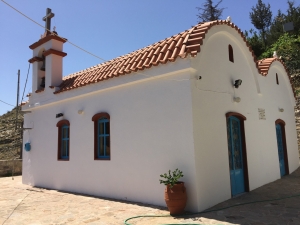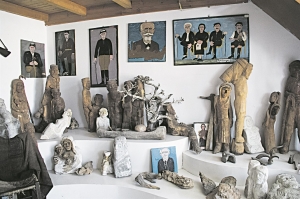Anogia is located 36km west of Heraklion and 52km southeast of Rethymnon, at an altitude of 750m. It is built on three levels in the ridge of Armi, on Psiloritis Mount. Its name means a place built on high level.
Anogia has particularly close relationships with Psiloritis range and its landscapes. The locals are mainly engaged in farming and are characterized by their hospitality. Here you can find genuine Cretans, who still wear the traditional clothes. The residents of Anogia seems to enjoy every moment of their lives and do not hesitate to express their joy with feasts, but if their pride is violated than guns talk!
In Anogia you can visit the old churches of St. George, St. Demetrius, the Assumption of the Virgin and St. John the Baptist (with frescoes of the 12th century). Also, you can enjoy your coffee in the cafes and taste the traditional Cretan dishes at local taverns, under the company of Anogians with their good heart and melodic accent. Moreover, women still weave traditional Cretan weavings of unsurpassed quality that you will find in many shops. Indeed, the first women's cooperation in Greece was founded in Anogia.
Anogia is famous throughout Greece for its contribution to culture. Indeed, great Cretan lyre players and singers come from Anogia with the most famous being Nikos Xilouris, whose house is located in Perachori. Lastly, each year the cultural events Yakintheia are organized in a lovely stone theatre next to the village, that is currently famous throughout Greece.
History
The area of Anogia was a very important place of worship in antiquity, as the cave of Ideon Andron in nearby Nida Plateau, was according to legend, the cave where Zeus was raised as a child. Also nearby is still the sacred spring of Agia Marina and the small palace of Zominthos, worshiped in the Minoan era.
Anogia was mainly inhabited in the 12th century, when it was granted by the Byzantine Empire as a fief to the family of Kallergis. During the Ottoman period, Anogia was a “wakf’ village dedicated to Valide Sultana, the wife of the Sultan. At the same time it gave birth to famous rebels who participated in almost all revolutions in Crete. The high mountainous geography of Psiloritis kept the Turks away and gave refuge to the rebels, even when the Turks burnt out the village in 1822 and 1867.
The free soul of Anogians did not seize when Crete was occupied by the Germans in 1941, when the Libertarian Action Committee was founded here. However, the most important moment in the history of the village was took place after the kidnapping of the German general Kraipe and its transfer to Anogia, before he was moved via the southern shores of Rethymno to Africa. The Germans surrounded the village and massacred all men who had not managed to escape in Psiloritis, before tearing all 800 houses in the village.
- 1
- 2

The Monastery of Saint Nektarios at Anogia is a female modern monastery built in a beautiful wooded location with nice view to the neighborhood Perahori of Anogia town.

The museum is dedicated to the folk artist Skoulas Alkiviades (Gryllios) who lived from 1902 to 1996 and was the father of the great Cretan musician Vasilis Skoulas.
- 1
- 2
















































































